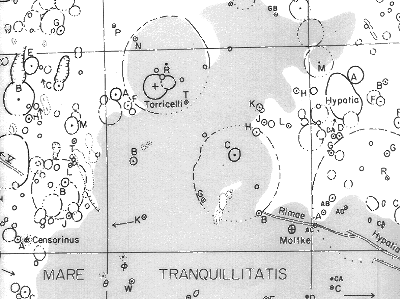
Map of Torricelli Area
Below is listed the predictions, as generated by the program.
Starting Date = 1998 / 1 / 1 U.T.
Site Longitude = 94.90 Latitude = 39.05 Elevation = 250 meters
Feature = TORRICELLI
Longitude = 28°30' Latitude = -4°36'
Reproducing Lighting For: 1997 / 10 / 6 at 21 : 57 UT
Desired Solar altitude = 3.543° (Rising), Azimuth = 89.093°
Average Co-longitude = 335.054
In the time column, D=daylight, T=twilight
---- Moon's ----
Topocentric -- Earth's -- ------- Sun's -------
UT Date Time Alt° Semi-diam" Long° Lat° Colong° Lat° Azim°
1998/ 3/ 3 20:28D 47.34 978.88 5.67 6.56 335.05 -0.08 89.79
1998/ 5/ 1 21:47D 60.79 945.26 7.47 4.66 334.94 -1.39 91.11
1998/ 6/29 20:21D 41.28 909.38 3.87 -1.55 334.95 -1.30 91.02
1998/ 8/27 18:45D 19.87 893.09 -1.72 -6.26 335.06 0.06 89.65
1998/10/25 19:50D 23.32 910.70 -5.75 -5.58 335.17 1.37 88.33
From the book The Moon, by Moore and Wilkins (Faber & Faber, 1955):
TORRICELLI, +475 -084 [Italian physicist, 1608-47]. A remarkable double ring, the larger component being on the west and 12 miles in diameter, with a slight break on the south. The smaller, eastern component is 5 miles in diameter, with the wall broken down at the point of contact with the larger ring, and with two minute craterlets at the point of junction on the south. Owing to the gap, Molesworth, Arthur and others have seen a ray of light, at sunrise, shining through the gap and onto the floor of the formation. Burrell and Thornton have seen a cleft traversing the floor of this object, shown, however, by Burrell as a craterpit-chain. The smaller ring also has a gap in its east wall, with a craterlet outside to the south, and the sunlight sometimes streams through this outer gap before passing through the inner and thence on to the floor. From the south wall, a long cleft is said to run to the east; Thornton and Moore have seen a ridge to the east of the smaller component. Two other, shorter and parallel clefts have been reported on the south, with another further east. Goodacre mentions the triple system of clefts on the south, but Thornton has hailed to confirm this with his 18 inch reflector. To the west are two more clefts on the rim of a large and prominent ancient ring, traceable in its entirety but very low in places, Torricelli being situated on its interior but not centrally. This ring must once have been a most imposing object; now, the wall is especially low on the north and here are some crater chains. They run parallel to the cleft from the north wall of Torricelli. Several minute craterlets will be found scattered over the interior of this old ring.
Thornton, 3 March 1952, found variations in the shadow on the inner west, afterwards confirmed by Wilkins; also a bright band on the inner slope. There is a fault across the western part of the floor, while on the east Thornton has seen a cleft crossing the floor and then up the south wall, to end in a minute depression on the rim.
